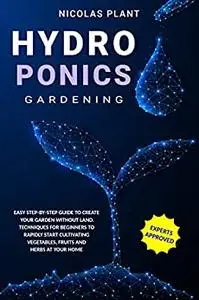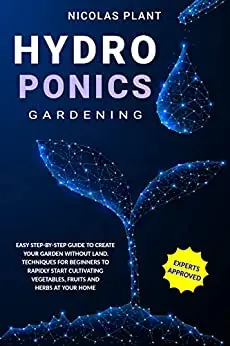HYDROPONICS GARDENING: Easy Step-by-Step Guide to Create Your Garden Without Land. Techniques for Beginners to Rapidly Start Cultivating Vegetables, Fruits and Herbs at Your Home by Nicolas Plant
English | 2020 | ISBN: N/A | ASIN: B0871LVFZK | 110 pages | EPUB | 1.12 Mb
English | 2020 | ISBN: N/A | ASIN: B0871LVFZK | 110 pages | EPUB | 1.12 Mb
Do you want to rapidly start cultivating vegetables, fruits and herbs at your home without using land?
If yes, then keep reading…
Hydroponics, or more correctly and in a general sense, soilless cultivation is a technology aimed at growing plants in a nutrient solution (water that contains nutrients) with or without the use of an artificial medium (sand, gravel, vermiculite, perlite, rock wool, etc.). Liquid hydroponic systems have no other means of supporting the roots of plants; systems in a solid medium, instead, use a substrate as support. Soil-free cultivation systems are also classified as open (when the nutrient solution draining from the roots is not reused) or closed (when the surplus solution is collected, corrected, and returned to the system).
Soil-free crops are mostly grown in the greenhouse, often requiring high technology and substantial capital. However, they are very productive, ergonomic, efficiently use space water, and (potentially) protect the environment.
Since in such agricultural systems the regulation of the air and radical environment is one of the main aspects, the production takes place through the parallel control of the temperatures of the air and of the roots, of the light, of the relative humidity of the air, of the water, plant nutrition and climatic adversities.
This book covers a plenty idea that surely you’ll be needed:
What is hydroponic gardening?
The benefits and disadvantages of hydroponics
Different kinds of hydroponic gardening
How to make your own system
Setup and run a hydroponic system
How to establish the budget and which type of plants, vegetables and herbs are best suited for each method of gardening
…And much more
Historically, hydroponic gardens date back to Babylon's Hanging Gardens and Mexico's Aztec Indians who had a method of growing crops on shallow lakes rafts. Hydroponics is hardly a new plant-growing process. In this revolutionary field of agriculture, however, giant steps have been taken over the years.
Developments in Europe did not begin until 1699 when Woodward found that it was possible to grow plants in a water solution to which soil had been added. Liebig, a German scientist, began to use nutrient solutions to study plant nutritional requirements in the 1850s, followed by Sachs in 1860 and Knop in 1861, who performed nutrient element studies in water solutions. In nutrient solutions made up of mineral salts, they were able to grow plants eliminating the need for soil.
Research on plant nutritional needs continued into the 1870s. In the greenhouse industry, practical applications of hydroponics were made by 1925. As researchers became aware of the potential to grow hydroponically, the next decade was to see extensive development.
Buying hydroponic crops and growing containers on a growth tent have many advantages. For those of you who don't know the differences between a grow tent and a box, we hope this article will explain it in detail. By the time you read this article, you are an expert in the field of grow boxes and grow tents and you know all the differences between the two unique grow enclosures. Growing tents is cheap and easy to make. A grow tent can be sold for much more than it costs to produce.
Feel Free to contact me for book requests, informations or feedbacks.
Without You And Your Support We Can’t Continue
Thanks For Buying Premium From My Links For Support
Without You And Your Support We Can’t Continue
Thanks For Buying Premium From My Links For Support



